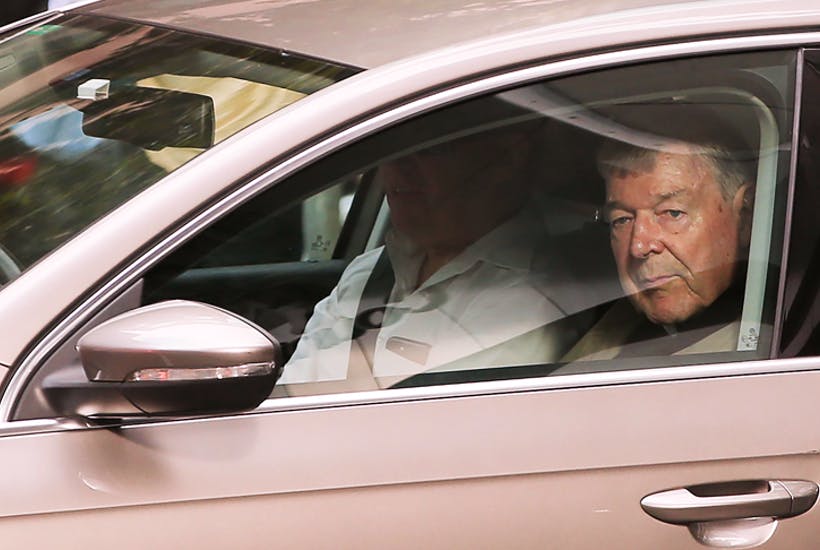On March 13th, Cardinal George Pell was sentenced to six years jail on charges of child sexual abuse. He will be eligible for parole in three years and eight months.
Some people have pounced on comments at sentencing made by Pell’s defence team, suggesting that these were admission of guilt. This is not the case.
In both Australian and UK courts, once a jury delivers a verdict of guilty, the defence may not dispute that finding (until any appeal is lodged) but has to address the court as if the fact of guilt were now established.
The presiding judge is under a similar obligation, so Justice Peter Kidd’s remark prior to sentencing that his comments and sentencing were made on the assumption that the offences took place as alleged is striking and unusual. I have been present during a number of criminal trials, and I have never heard any judge say anything similar, almost as if he were distancing himself from the verdict, and making it clear he was going through the motions as required.
Why would he do this? Perhaps because the evidence falls far short even on a balance of probabilities basis, let alone where guilt is required to be proven beyond a reasonable doubt. There is a principle in English and Australian jurisprudence that if there is a reasonable explanation of the evidence that is consistent with the defendant’s being innocent of the charges, a verdict of not guilty must be returned.
Not only were there reasonable alternative explanations of the evidence, but on the evidence given in court by multiple witnesses, it was simply impossible for Cardinal Pell to have committed the offences as alleged.
Some people have suggested that since the court was closed, no one can know what the evidence was, and therefore no one apart from the jury knows the full story. But this is not the case. The court was not closed. Several journalists and members of the public attended throughout. Media suppression is not the same thing as a closed court. That simply meant that details of the case could not be published in Australia until the suppression or der was lifted.
The prosecution’s case was that following Mass at the Cathedral, Archbishop Pell had found two boys in the sacristy drinking altar wine, and had forced them to give him oral sex. The “second victim,” who died before the case came to trial, had said specifically that nothing of the sort ever took place. The entire case against Cardinal Pell was the testimony, more than twenty years after the alleged events, of a single person whose credibility was not permitted to be challenged in court.
The prosecution did not dispute that after Mass Archbishop Pell had been at the door of the Cathedral greeting parishioners as they left, or that after this, he had been in the company of several other people until he left for another function.
The only time in which the alleged offences could have occurred were in the period after the final blessing, until the exit procession arrived at the main doors.
In summary, this is what the prosecution claimed on the basis of the word of a single, uncorroborated witness:
As the procession was forming to leave, two choir boys absconded, unnoticed by anyone at the time or later. At about the same time, the Archbishop, celebrating in his Cathedral for one of the first times, also absconded, also unnoticed by anyone else in the procession, or the hundreds of other people in the Cathedral. The boys returned to the busiest room in the Cathedral at that time, the sacristy, where they found some altar wine which they began to drink, even though altar wine is never left there unattended.
According to the alleged victim, neither the sacristan nor any of the other altar servers or helpers, who would normally be constantly in and out of that room at the time, were anywhere to be seen. Archbishop Pell entered the room, unseen by anyone, and demanded the boys give him oral sex.
It was not disputed that he was wearing his eucharistic vestments. These consist of a close fitting cassock with thirty-nine buttons from top to bottom, a cincture – a wide band around the waist of the cassock, an alb, a long white robe tied with a rope or cord (both cassock and alb are full-length garments, reaching from neck to floor), and over these a dalmatic and a chasuble, both heavy brocade garments reaching to the knees.
Evidence given by the prosecution’s single witness was that these garments were pushed aside. They cannot be pushed aside. It is just possible that they could be lifted enough to give access to everyday clothes underneath, and that these could then be opened, but the cassock, alb, dalmatic and chasuble would need to be held with one hand the entire time. It would tight and uncomfortable, and movement would be almost impossible. This would still be the case even if Pell were wearing only an alb, stole and chasuble over his street clothes, as some parish clergy do.
The prosecutions’ case is that having taken a few minutes to lift these tight, heavy garments and open his normal clothes underneath, the Archbishop, with very limited movement and one free hand, chased the two boys around the sacristy, unnoticed by the large number of people moving between that room and the sanctuary, forcing each of the boys to give him oral sex.
He then masturbated to completion, rearranged his garments, walked back through the Cathedral and re-joined the procession before it arrived at the Cathedral door, again without anyone noticing, while the two boys re-joined the choir, also without anyone noticing either that they were back or that they had been gone.
All of this, according to the prosecution, from the time the procession left the sanctuary to the time it arrived at the door, about one hundred metres distance, took place in about five minutes. In reality (I have been to mass at that Cathedral) about three minutes. Three minutes!
The story is manifestly ludicrous. It is impossible, simply silly.
Juries get things wrong. Facts can be complex, laws confusing, and trials long. But the finding of the jury in this case is unaccountable. The verdict is not an indictment of Cardinal Pell, far less the Catholic Church as a whole, but of Australia’s mainstream media, and Victorian Police.
Operation Tethering, the Victorian police investigation into Cardinal Pell, started in 2013. It was not set up to consider complaints of criminal behaviour; there hadn’t been any. It was set up to generate them. This campaign included the placing of advertisements in Victorian newspapers inviting people to make complaints. If you invite complaints, you will get them. The police had their man. They just needed a suitable victim.
Comparisons have been made between the calumnies heaped on Pell by the media, and the feeding frenzy of hate and condemnation directed at Lindy Chamberlain between 1980 and 1988. The media have been evil angels in both cases, and in the case of Henry Keogh, and of Archbishop Wilson, and others. A rush to gleeful condemnation has become an ugly, but presumably profitable, feature of some parts of Australia’s mainstream media. But at least in the Chamberlain and Keogh cases, something had happened which required investigation. Juries in both cases were misled by mind-bogglingly incompetent forensic experts. For Cardinal George Pell, there were no incidents or complaints to investigate. Police had to go hunting for offences with which to charge a man they had already decided was guilty.
The verdict will be overturned on appeal. But massive harm has been done, to Cardinal Pell himself, of course, to the credibility of Australia’s media and judicial system, and not least to genuine victims.



